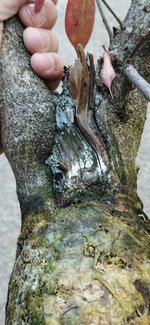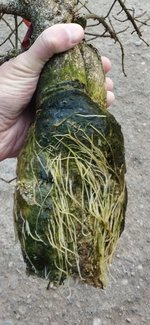itisoktodance
Sapling
Can an airlayer be too large?
There's a silver maple outside my building that I'm interested in preserving via bonsai (I know it's not a good bonsai subject, not the point of this thread). The tree is hollowed out and is likely to be condemned in the spring (or the year after). Is there a chance I could airlayer the top section off it? It's around 30cm wide where I'm planning to cut, and probably more importantly, it's just half a trunk (see attached images).


The two main issues I see are:
1. It's only half a trunk. However, it's obviously still alive, so it has that secondary phloem that we need for an airlayer.
2. It's very wide, an entire 30cm in what would be its diameter.
Thus my main questions are: 1. Is it possible at all to airlayer a hollow trunk tree? and 2. Is it possible to airlayer such a large section?
Thank you in advance!
As a P.S. for why I'm interested in this tree at all, it's mostly for sentimental reasons. The boulevard here is lined with these beautiful silver maples that have an amazing bark, such that I really haven't seen on other silver maples in the city (they are not a native species). However, cilmate change is real and the summers have been getting hotter and drier, and most of the trees here are dying because of it. They dry up from the drought and then heavy winds knock them down. This one already had its top die off, but amazingly it survived. This is why I'm interested in this particular tree, even if silver maples aren't good for bonsai. I'm perfectly happy with just keeping a piece of it alive.
There's a silver maple outside my building that I'm interested in preserving via bonsai (I know it's not a good bonsai subject, not the point of this thread). The tree is hollowed out and is likely to be condemned in the spring (or the year after). Is there a chance I could airlayer the top section off it? It's around 30cm wide where I'm planning to cut, and probably more importantly, it's just half a trunk (see attached images).


The two main issues I see are:
1. It's only half a trunk. However, it's obviously still alive, so it has that secondary phloem that we need for an airlayer.
2. It's very wide, an entire 30cm in what would be its diameter.
Thus my main questions are: 1. Is it possible at all to airlayer a hollow trunk tree? and 2. Is it possible to airlayer such a large section?
Thank you in advance!
As a P.S. for why I'm interested in this tree at all, it's mostly for sentimental reasons. The boulevard here is lined with these beautiful silver maples that have an amazing bark, such that I really haven't seen on other silver maples in the city (they are not a native species). However, cilmate change is real and the summers have been getting hotter and drier, and most of the trees here are dying because of it. They dry up from the drought and then heavy winds knock them down. This one already had its top die off, but amazingly it survived. This is why I'm interested in this particular tree, even if silver maples aren't good for bonsai. I'm perfectly happy with just keeping a piece of it alive.




